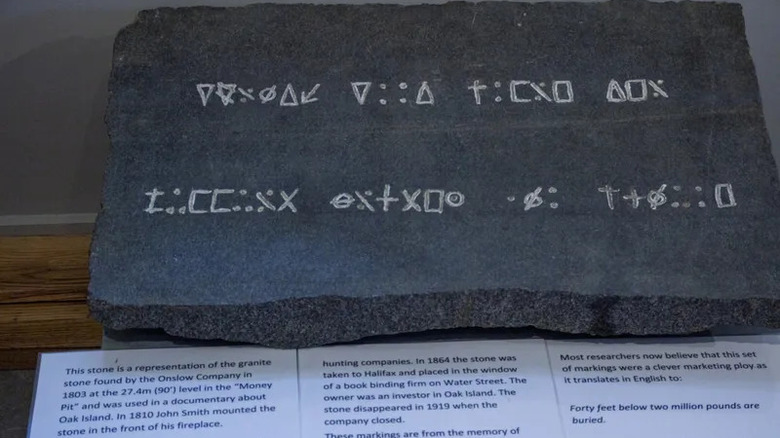This Mysterious 90-Foot Slab Brought More Questions Than Answers To Curse Of Oak Island Investigators
Everyone loves a good treasure hunt, and it's one of the reasons that "The Curse of Oak Island" has proven so popular. In today's hyper-connected, endlessly Google-able world, there is a certain thrill in knowing that mysteries still exist.
This is particularly true when the mystery is purportedly deadly, like the legend of a curse. The legend goes that seven people must die before the treasure is discovered. By some counts, six have already died. Given that the site of the treasure — dubbed the "Money Pit" — is supposedly booby-trapped, periodically flooding as the Lagina brothers continue to dig their way down, that number seems one to be taken seriously.
There's also a very real impetus to figure out ways to safely navigate the pit. That's where the 90-foot slab comes in. To be clear, the slab in question is not 90 feet long. No, this is a stone slab (tablet might be a more accurate word) that was allegedly found about 90 feet down in the Money Pit. According to the Oak Island Mystery website, nothing about the slab seemed to fit. It was hewn from a stone that wasn't native to Nova Scotia, and, most importantly, had strange runic carvings on it.
What does the 90-foot slab say?
The stone has been long lost to time, first reportedly being kept in the home of the Smith family, then popping up in the window of a shop in Halifax. As for the stone's writing, no rubbings of it exist, but the markings are generally accepted to look a specific way. In 1949, a reverend named A.T. Kempton supposedly translated the writing, and argued that it said: "40 feet below 2 million pounds are buried."
That seems very clear. Keep digging into the Money Pit, and after another 40 feet, the famed treasure of Oak Island — anything from Marie Antoinette's crown jewels to the mythical riches of the Knights Templar — will be found. Except that a guest expert from one episode of "The Curse of Oak Island" disagrees.
In Season 2, Episode 5 — aptly titled "The 90-Foot Stone" — cryptographer Daniel Ronnstam interprets the writing as being "two codes in one," combining both English and Spanish translations. Ronnstam's version of the code comes to "at 80 feet corn long narrow sea inlet drain." He also suggests that this could be a set of instructions aimed at helping excavators and treasure hunters avoid the pit's many booby traps.

